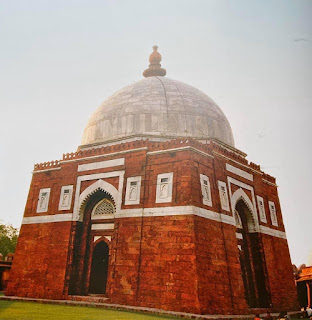Delhi Heritage Trail : 34
Tomb of Ghiyasuddin Tughlaq
This is one of the beautiful Tomb of the Sultanate Era and a architectural marvel. A student of architecture should definitely visit this 650 year old monument. Despite the deep rooted disapproval of monumental tombs in Islam Delhi is dotted with more than 150 tombs of various shape,size and grandiose nature. The tomb is situated two kms from Tughlakabad Fort near Mehrauli-Badarpur road. It has a Fortress like appearance with liberal use of Red sandstone and white marble and was once in the midst of a water body.
Ghiyasuddin was Governor of Samana near Panipat. When Allauddin Khalji expired in 1316 confusion prevailed in Delhi when usurper Khusrau Khan seized the throne. Ghiyasuddin marched to Delhi killed Khusrau Khan and declared himself Sultan in 1321 starting the Thuglaq Era. He was an able ruler an ambitious builder and kept the Mongols at bay. The Tughlaq era monuments were known for their slopping walls of massive strength, rough stones and without much ornamentation. Tughlakabad the fourth city of Delhi was built by them.
The tomb is an imposing edifice befitting a warrior king. A stone causeway led to the tomb which is now breached. The fortified outer walls of the tomb now stand in good shape and intact. Called Darul Aman (Abode of peace) there is a sense of eerie silence and tranquility here. It is said that the sultan was enchanted by this place that he started constructing the tomb during his life time. The Sultan had a tiff with the contemporary Saint Nizamuddin Auliya and was envious of his popularity.
His death is also shrouded in mystery. After a victorious campaign in Bengal he was returning to Delhi and was resting in Afghanpur a days distance from Delhi. His son Mohammed (later to be crowned Mohd. Bin Tughlaq) arranged a lavish reception to him. As the Sultan sat reviewing the troops the roof of the pavilion crashed on him and he died. While some call it accident others attribute it to Mohammed’s greed and ambition to sit on the throne of Delhi earlier.


No comments:
Post a Comment